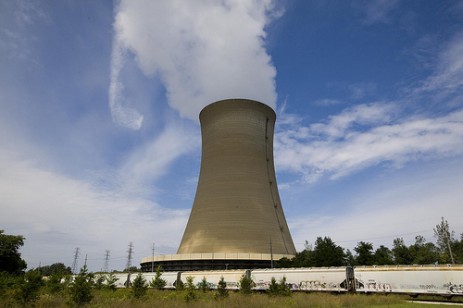In the wake of a massive quake and a tragic, deadly tsunami, Japan is also dealing with a nuclear catastrophe. Sen. Joe Lieberman (I-Conn.) has said that this should inspire us to “put the brakes on” nuclear development until further notice, and China and Germany are shutting down development and existing reactors. But what about safer options? Do they exist, and would they make a difference?
The core of a molten salt reactor, some of which use thorium fuel.Thorium fuel. The radioactive element thorium has been floated as a safer alternative to uranium for nuclear power. Thorium waste doesn’t stay radioactive as long (only 500 years, which is really short comparatively) and it doesn’t create plutonium as a byproduct. One possible thorium reactor design doesn’t fission without a kick-start from a particle accelerator. So if the power goes out, the reaction will stop, because it won’t be getting that kick. Most of these safer alternatives, including thorium, aren’t in wide commercial operation, because the ship of nuclear power is steered so slowly. But it may have potential.
Passive safety. The Fukushima plants’ safety plan — which probably would have worked in a less devastating disaster — relied on multiple backup generators to continue to provide power to pump water into the core in order to cool it. Passive safety measures [PDF], by contrast, are designed to work in the absence of power. So, for example, a drop in core pressure (which would indicate that there wasn’t enough cooling water being pumped in) would trigger a valve to open on a reserve tank, and the core would flood with borated water (water plus borium), which can stop nuclear reactions. There’s a whole range of things that are considered “passive safety,” and some are more failsafe than others. But if the plant loses power, it’s nice to have some security measures that don’t need power to kick in. (And there’s no rule that says you can’t mix and match active and passive systems.) China has started building Westinghouse AP1000 reactors, which use passive safety, but they haven’t been approved yet in the U.S.
Thermal expansion: One promising type of passive safety relies on the fact that you need a lot of uranium close together in order to have a nuclear fission reaction (which is what generates power). If the fuel is surrounded by something that expands when it heats, overheating causes the radioactive bits to spread further apart, shutting down the reaction. (Imagine raisins in bread dough. As the dough rises, the raisins get further apart. If those raisins were radioactive, that would be a good thing, although you still wouldn’t want to eat the bread.) Reactors can be built to maximize this effect by embedding the fuel in a thermally expansive material. The Integral Fast Reactor, which used liquid sodium for cooling, was an example of this type of design, but it was defunded because of concerns about nuclear proliferation.
A graphite pebble from a pebble bed reactor.Photo: Stefan KühnReactivity feedback: Other passive safety reactors take advantage of the fact that uranium fuel is more likely to absorb neutrons when it’s heated up. Nuclear reactions depend on neutrons colliding with atoms, so taking neutrons out of circulation means nuclear reactions become less likely. (Imagine a game of Russian roulette with your head as an atom and the neutrons as bullets — if you could rig the gun to absorb the bullets, your chances would improve.) In a design that maximizes this effect, hotter fuel means lower reactor power — more and more neutrons are absorbed, and fewer and fewer are available for reactions. An overheated reactor will throttle itself down instead of continuing to increase in temperature. Pebble bed reactors, like the kind that are — or rather, were — being built in China, use this effect for safety.
Is any of this going to be enough to overcome people’s understandable suspicion of nuclear power? Right now, it might take an ad campaign beyond the dreams of Sterling Cooper — not least because none of these innovations is foolproof. But there are ways to make nuclear less dangerous and less polluting while still meeting high energy demands. Can we say that about coal?


